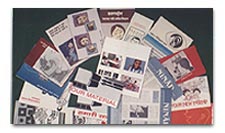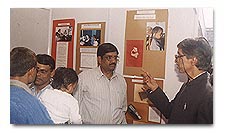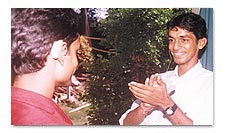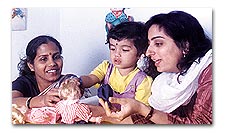BOOKS FOR YOU TO READ AND DOWNLOAD
- LANGUAGE OF ADVERTISEMENTS IN TAMIL by Sandhya Nayak, Ph.D.
- An Introduction to TESOL: Methods of Teaching English to Speakers of Other Languages by M. S. Thirumalai, Ph.D.
- Transformation of Natural Language into Indexing Language: Kannada - A Case Study by B. A. Sharada, Ph.D.
- How to Learn Another Language? by M.S.Thirumalai, Ph.D.
- Verbal Communication with CP Children by Shyamala Chengappa, Ph.D. and M.S.Thirumalai, Ph.D.
- Bringing Order to Linguistic Diversity - Language Planning in the British Raj by
Ranjit Singh Rangila,
M. S. Thirumalai,
and B. Mallikarjun
REFERENCE MATERIAL
- Languages of India, Census of India 1991
- The Constitution of India: Provisions Relating to Languages
- The Official Languages Act, 1963 (As Amended 1967)
BACK ISSUES
- E-mail your articles and book-length reports to thirumalai@bethfel.org or send your floppy disk (preferably in Microsoft Word) by regular mail to:
M. S. Thirumalai
6820 Auto Club Road #320
Bloomington, MN 55438 USA. - Contributors from South Asia may send their articles to
B. Mallikarjun,
Central Institute of Indian Languages,
Manasagangotri,
Mysore 570006, India or e-mail to mallik_ciil@hotmail.com. - Your articles and booklength reports should be written following the MLA, LSA, or IJDL Stylesheet.
- The Editorial Board has the right to accept, reject, or suggest modifications to the articles submitted for publication, and to make suitable stylistic adjustments. High quality, academic integrity, ethics and morals are expected from the authors and discussants.
Copyright © 2001
M. S. Thirumalai
TEACHING MATERIALS FOR THE CHILDREN WITH HEARING IMPAIRMENT
Sam Mohanlal, Ph.D.

1. LINGUISTIC IMPAIRMENT IN THE HEARING IMPAIRED
Deafness causes some linguistic impairment, but the hearing impaired children have the intellectual and emotional potential often intact. They can learn like any other normal children when information is presented to them. A congenitally deaf child, with severe and profound loss of hearing, fails to acquire language and speech. Subsequently the child fails to achieve proper verbal communication.
2. LINGUISTIC AND OTHER ASPECTS OF HEARING IMPAIRMENT
Even with this category of children, we can develop their communication potential if the teaching methodology carefully takes care of their needs in the Indian context. These materials should have specific linguistic, environmental, and psychomotor activities, and other components. Each teaching unit must be goal-oriented and should be so graded that the children irrespective of their level of hearing impairment will achieve at least a part of the objectives of the teaching components in a particular lesson or unit. In order to achieve this goal, the materials should have a three-way division as follows:
- Linguistic aspects: the development of basic verbal communicative skills;
- Socio-psychological aspects: the development of moral and civic values of life; and
- Productive aspects: development of psychomotor activities.
3. THE CHALLENGE BEFORE THE MATERIALS PRODUCER: LINGUISTIC HETEROGENEITY
Before one begins the material production, it is wise to look into the nature of the target group in the Indian context. In the Indian context, we notice some striking heterogeneity among the hearing impaired children based on environmental, linguistic, and social variables.

For example, rural versus urban is an important variable. The age at which a child enters the school, gender of the child, the differential quality of hearing impairment, the quality of parental care, the quality of parental awareness and preparation, the quality of non-parental care, religious and other belief assumptions regarding deafness, family economic condition and overall hygiene, etc. can have great impact on the development of the communication skills in the hearing impaired child.
When a family is not prepared or equipped to give proper motivation for communication even to a so-called normal child, how could we expect that family to take care of the hearing impaired child in such a way that the hearing impaired child will be nurtured with suitable communication help? The children, born to poor parents and brought out in very congested localities, come to the deaf or normal school with definite disadvantage. These children need more intensive help than others coming from relatively better off families.
Also I noticed that children coming from families that speak a language at home that is quite different from the language of the majority of the people in the locality are kept in the same class with children who hail from the families that speak the dominant language of the area as their home language. I noticed that in every class of deaf students there might be 5-8 different linguistic groups represented! I also identified different regional dialectal groups among the children. This is observed mostly in the urban areas of Tamilnadu, India. This is a great challenge to the teachers, administrators, and materials producers.
To this complexity, add the fact that children with congenital hearing impairment would have their own special needs regarding the teaching methods, quality of understanding, concepts, language, etc.
With such heterogeneity, it looks as if it is impossible for any materials producer to produce a reasonably effective material to cater to the needs of a heterogeneous group such as the one we find in the Indian population.
4. THE CHALLENGE BEFORE THE MATERIALS PRODUCER: SOCIAL AND ECONOMIC HETEROGENEITY
Social and economic differences play a crucial part. We see that in a deaf school children coming from different social backgrounds such as the children of educated parents, illiterate parents, business community, casual laborers, etc. are all put together.

Rural Vs Urban is important distinction. Even in the urban schools one can find children from rural or semi-urban areas and, in rural schools, we find children whose parents are settled in urban areas. The children with hearing impairment are being reared by their grand parents or by some other distant relatives. These children have periodic urban contact though they study in rural schools.
School entry level
In most of the schools where hearing impaired children are admitted, the common experience is that in the pre-primary classes one can find enrollment of children at the age of 0 and also at the age of 8 or 10. Hence one can find in the pre-school level the range of age for the children are from 0 to 10. There are several reasons for this phenomenon, such as non-identification of the impairment social stigma not willing to send the hearing impaired child to the schools.
Problems related to finance.
Age
The heterogeneity related to age is posing lot of problems for developing language skills because the older children in the same class will have mental and social maturity, but language learning ability level may be very low whereas the younger children sometimes will have high language learning ability. At the same time they are socially and mentally not matured. In such situation often the older children spoil the younger children and also both the groups loose interest in language learning.
Gender

The presence of both the genders together in schools too possess different kinds of problems that are often found to get affected in their language learning ability.
Differential hearing impairment
In the same class it is found that the nature and kind of hearing impairment also not controlled. One can often find varied differences in hearing impairment. This too poses problems for language learning because teaching technique and materials vary according to the nature of the impairment, which is not controlled in the situation.
Parental care versus non-parental care
There are many children who come from the home where there is no parental care. These children often get depressed in the class. Always they are found to be in deep thoughts and lost. Whenever these children observe other groups of children whose parents come to the school and talk to their wards, they either get wild or refuse to co-operate with the class teacher in obeying to her/his orders.
5. LACK OF CURRICULUM
In spite of all the above-mentioned heterogeneity in the pre-school classes, there are no specific guidelines available to the teachers. Among the teaching fraternity one can find even inexperienced teachers. They are expected to prepare their own curriculum. Many a times, because of the non-availability of curriculum, the teachers are forced to use any textbook in the class. This results in severe problems in language learning ability.
6. HOW TO RECTIFY?
In order to rectify the defects we have designed an annotated pre-school curriculum by taking into consideration all the variables discussed above. Before designing this annotated curriculum we have also taken into consideration the various types of errors committed by the children while speaking and writing the language concerned. This project involved Tamil.
The curriculum has total three stages, as follows.
- 1st stage0 to 3 years
- 2nd stage3 to 4 years
- 3rd stage4 to 5 years
All the stages have the following 11 learning components.
- Language component
- Songs
- Practical lessons to develop psychomotor activities
- Story
- Conversation
- Listening exercises
- Pronunciation practice
- Games
- Mathematics
- Moral Instruction, and
- Handicrafts
All the above 11 learning components are selected very carefully. Each component will fulfill certain specific objectives systematically. Also, within each component, the academic thrust varies with the objective of catering to the academic needs of the existing heterogeneity in the class.
7. INSTRUCTIONS TO THE TEACHERS
While incorporating the learning components mentioned above, the special education teachers are given the following instructions.
- Encourage in the class meaningful and enjoyable activities in order to achieve maximum language input.
- Encourage both question and answer as a technique in the class. As and when the child responds to the teacher the teacher will expand the child's single or two -word utterances into meaningful sentences.
- Children are encouraged to perform actions and teachers are instructed to give the appropriate simple sentences for the child's non-verbal actions. This technique provides very good result over a period of time.
- As far as possible the children are inspected properly for wearing a suitable hearing aid.
- A good number of varied simple activities is included which can allow the use and association of words in a number of situations. This kind of repetition of words and sentences would enhance the child's language learning ability.
- Encourage the children even to utter a wrong word and the teachers are instructed to utter only the correct word after the child utters a wrong word.
- Each new activity needs to be repeated once a week or at least twice a month for constant reinforcement in learning.
- Constant use of flash cards and keep blank cards for entering the child's response whenever needed.
8. SPECIFIC TECHNIQUES FOR LANGUAGE TEACHING
Throughout the pre-school level of teaching, the special schoolteachers are advised to follow two kinds of teaching techniques as follows.
- Teaching through auditory mode and,
- Teaching through visual mode.
The two kinds of teaching modes mentioned above should be simultaneously used. The teachers are advised to get the class involved by creating a teaching content with the help of the students. We found that this first level student involvement could create a psychological homogeneity even in the highly heterogeneous class.
As and when the teacher could identify a content as given by the students which can suit the syllabus, the teacher is advised to take that lead and create her/ his own lesson by following the guidelines given in the annotated syllabus.
The next step as a technique, we advise the teacher to speak in full sentences relevant to the situation with more stress and repetition of the main words that are needed to develop the content. This act of the teacher will function as reinforcement for the students. We found that with this technique the students get stabilized with the required pronunciation. The whole process is simultaneously demonstrated through usual mode by using relevant gestures.
In addition to the presentation explained above, the instructional materials need to have classified lexical items on the basis of some rationality when we teach vocabulary. For instance, domestic animals in one section, wild animals, birds, colors, in another section, etc. When we teach the structures we have adopted graded structures. At every stage lots of exercises are given with an objective of having more interaction with the children. It is the interactivity, which often give more thrust for the learning capability of the hearing impaired. The interactivity can be achieved by asking several questions on the basis of the content of the lessons introduced. For instance, when we conducted experiments we did so by asking series of questions such as:
- Which is the part of the body used for speaking?
- Which is the part of the body used for walking?
- Which is the part of the body used for listening? etc.
These questions we have introduced after the children are exposed to the concerned parts of the body and their functions. The children are often seen giving answers with the appropriate action. This helps the children to systematically learn things and also help them in internalizing the clear concepts regarding the learning components.
9. TO CONCLUDE
This is only a beginning. We would like to closely monitor the teaching practices of the teachers in the pre-school classes when they deal with the children they suspect to be hearing impaired. We would like to give some special orientation to selected teachers so that they will begin to maintain some records of their own teaching methods and the ways by which children respond to specific methods adopted.
*** *** ***
HOME PAGE | Reconciling Linguistic Diversity: The History and Future of Language Policy in India | English Only, English Plus, and Reconstructing Ethnic Identity Via Language: Language Movements in the U.S.A. | LANGUAGE OF ADVERTISEMENTS IN TAMIL MASS MEDIA | Language News This Month -- Judging Curses | CONTACT EDITOR
Sam Mohanlal, Ph.D.
Central Institute of Indian Languages
Manasagangotri, Mysore 570006, India
E-mail: mohan@ciil.stpmy.soft.net.